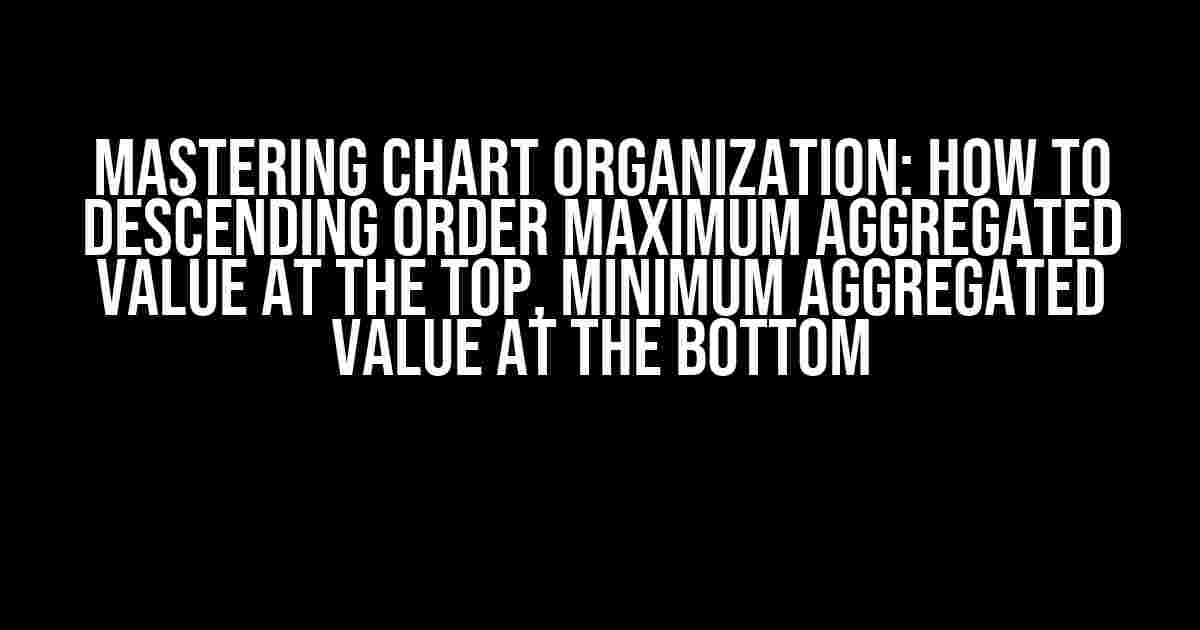Are you tired of cluttered and confusing charts that make it difficult to visualize your data? Do you want to create stunning visualizations that effectively communicate insights to your audience? Look no further! In this comprehensive guide, we’ll walk you through the steps to descending order maximum aggregated value at the top and minimum aggregated value at the bottom in a chart, just like the image below.

Why is Chart Organization Important?
Before we dive into the tutorial, let’s discuss the importance of chart organization. A well-organized chart can make all the difference in how effectively your data is communicated. A clear and concise visualization can help your audience:
- Quickly identify trends and patterns
- Make informed decisions based on data-driven insights
- Stay engaged and interested in the information being presented
Step 1: Prepare Your Data
The first step in creating a beautifully organized chart is to prepare your data. This involves:
- Cleaning and filtering your data to remove any unnecessary or irrelevant information.
- Aggregating your data to calculate the maximum and minimum values.
- Sorting your data in descending order to prioritize the maximum aggregated values.
// Example code in Python
import pandas as pd
# Load your data into a Pandas dataframe
df = pd.read_csv('your_data.csv')
# Filter and clean your data
df = df.dropna() # Remove rows with missing values
df = df.drop_duplicates() # Remove duplicate rows
# Aggregate your data
df_agg = df.groupby('category').agg({'value': 'sum'})
# Sort your data in descending order
df_agg = df_agg.sort_values('value', ascending=False)
Step 2: Choose the Right Chart Type
The next step is to choose the right chart type to effectively visualize your data. For this example, we’ll use a bar chart, which is ideal for comparing categorical data.
Why a Bar Chart?
A bar chart is a suitable choice for several reasons:
- It’s easy to read and understand
- It’s suitable for categorical data
- It allows for easy comparison between categories
Step 3: Create Your Chart
Now it’s time to create your chart using your preferred data visualization tool or library. For this example, we’ll use D3.js, a popular JavaScript library for creating interactive and dynamic charts.
// Example code in D3.js
const margin = { top: 20, right: 20, bottom: 30, left: 40 };
const width = 500 - margin.left - margin.right;
const height = 300 - margin.top - margin.bottom;
const xScale = d3.scaleBand()
.domain(df_agg.index)
.range([0, width])
.padding(0.2);
const yScale = d3.scaleLinear()
.domain([0, df_agg['value'].max()])
.range([height, 0]);
const svg = d3.select('body')
.append('svg')
.attr('width', width + margin.left + margin.right)
.attr('height', height + margin.top + margin.bottom)
.append('g')
.attr('transform', `translate(${margin.left}, ${margin.top})`);
svg.selectAll('rect')
.data(df_agg)
.enter()
.append('rect')
.attr('x', d => xScale(d.category))
.attr('y', d => yScale(d.value))
.attr('width', xScale.bandwidth())
.attr('height', d => height - yScale(d.value));
Step 4: Customize Your Chart
The final step is to customize your chart to make it visually appealing and easy to understand. This includes:
- Adding axis labels to provide context for your data.
- Customizing the colors to match your brand or style.
- Adding interactive elements to enable users to hover over or click on individual bars for more information.
| Customization Option | Description |
|---|---|
| Axis Labels | Add context to your chart by including axis labels for the x-axis and y-axis. |
| Colors | Choose a color scheme that matches your brand or style to make your chart visually appealing. |
| Interactive Elements | Add hover-over or click events to enable users to access more information about individual data points. |
Conclusion
In this comprehensive guide, we’ve walked you through the steps to descending order maximum aggregated value at the top and minimum aggregated value at the bottom in a chart. By following these steps, you’ll be able to create stunning visualizations that effectively communicate insights to your audience.
Remember to:
- Prepare your data by cleaning, filtering, and aggregating it
- Choose the right chart type to effectively visualize your data
- Create your chart using your preferred data visualization tool or library
- Customize your chart to make it visually appealing and easy to understand
With these skills, you’ll be well on your way to creating beautiful and informative charts that will leave a lasting impression on your audience.
Final Thoughts
Data visualization is an art that requires patience, practice, and attention to detail. By mastering the skills outlined in this guide, you’ll be able to unlock the full potential of your data and create stunning charts that drive insights and inform decision-making.
So, what are you waiting for? Start creating your chart today and take your data visualization skills to the next level!
Happy charting!
Frequently Asked Questions
Get the scoop on how to descend into the world of chart mastery! 📊
How do I sort my chart in descending order to show the maximum aggregated value at the top?
Easy peasy! To sort your chart in descending order, simply click on the “Sort & Filter” button, select “Sort Z to A”, and voilà! Your chart will be sorted in descending order, with the maximum aggregated value at the top and the minimum at the bottom.
What if I want to customize the sorting criteria?
No worries! You can customize the sorting criteria by using the “Sort & Filter” button and selecting the specific column or field you want to sort by. You can also choose from various sorting options, such as alphabetical, numerical, or custom sorting.
Can I sort multiple columns at once?
You bet! Most charting tools allow you to sort multiple columns at once. Simply hold down the “Shift” key while selecting the columns you want to sort, and then click on the “Sort & Filter” button. This will sort your chart based on the multiple columns you selected.
How do I reset the sorting order to its original state?
No sweat! To reset the sorting order to its original state, simply click on the “Sort & Filter” button and select “Reset sorting” or “Original order”. This will restore your chart to its original sorting order.
Are there any shortcuts to sort my chart in descending order?
You’re in luck! Most charting tools offer shortcuts to sort your chart in descending order. For example, you can press “Ctrl + Shift + Z” (Windows) or “Cmd + Shift + Z” (Mac) to sort your chart in descending order. Check your charting tool’s documentation for specific shortcuts!


